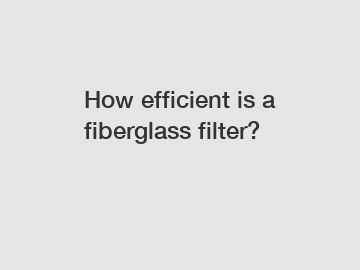How efficient is a fiberglass filter?
When it comes to air filtration systems, efficiency is paramount. Maintaining clean and healthy indoor air is crucial for our well-being, and the filter plays a vital role in achieving this goal. Fiberglass filters have long been a staple in the industry, but how efficient are they really? In this comprehensive guide, we will delve into the efficiency of fiberglass filters, debunk common misconceptions, and provide you with all the insights you need to make an informed decision for your indoor air quality.
Diving into Efficiency:
Fiberglass filters are known for their affordability and widespread availability. However, their efficiency often depends on various factors. Generally, these filters excel at capturing larger particles, such as dust, pollen, and lint. The tight weave of the fiberglass material enables them to trap these types of contaminants effectively. However, when it comes to smaller particles like bacteria, viruses, or smoke, the effectiveness of standard fiberglass filters may diminish.

Understanding the MERV Rating:
To gauge the efficiency of an air filter, one must refer to its Minimum Efficiency Reporting Value (MERV) rating. It quantifies a filter's ability to remove different-sized particles from the air. The higher the MERV rating, the better the filtration. Fiberglass filters typically fall into the lower range of MERV ratings (1-4), indicating they primarily serve to protect your HVAC system rather than provide superior air filtration.
Considerations for Optimal Efficiency:
While fiberglass filters can effectively combat larger particles, there are several crucial considerations to enhance their efficiency. Regular filter maintenance and replacement are essential. Clogged or dirty filters inhibit airflow, causing strain on your HVAC system and reducing filtration efficiency. As a general guideline, experts recommend replacing fiberglass filters every 30-60 days, depending on your specific circumstances.
Furthermore, supplementing your filtration system with additional measures can significantly improve indoor air quality. This may include employing air purifiers, investing in higher MERV-rated filters, or combining fiberglass filters with activated carbon filters to tackle odor and volatile organic compounds (VOCs).
Additional resources:Efficient Air Purifier Filters: A Must-Have in Denmark
What is the cheapest way of desalination?
What is a structure used to safely divert floodwater through or around a dam?
Which industries can revolutionize using recycled plastic pellets?
Purifier Filter Denmark: Which Innovative Technology Revolutionizes Indoor Air Quality?
Deep Dive Into Denmark's Best Vacuum HEPA Filters
Which is the most cost-effective Containerized Sewage Treatment Plant to purchase?
Debunking Myths:
Fiberglass filters have faced criticism in the past due to certain myths surrounding their efficiency. One misconception is that the blue dye on some filters indicates better filtration. In reality, the blue dye is merely a marketing tactic and has no impact on the filter's efficiency. Another common misconception is that thick fiberglass filters are superior. The thickness of the filter does not necessarily correlate with its efficiency; it is the MERV rating that truly matters.
Exploring Alternatives:
While fiberglass filters have their limitations, they remain a cost-effective option for many households. However, if you are seeking higher levels of filtration, exploring alternative options might be worthwhile. Pleated filters with higher MERV ratings, such as electrostatic filters or HEPA filters, provide superior filtration capabilities for smaller particles, allergens, and volatile substances.
Consulting with Experts:
Amidst the vast array of filter choices in the market, seeking professional advice is always recommended. HVAC technicians or indoor air quality experts can evaluate your specific needs and offer suitable recommendations tailored to your circumstances. Their expertise will help you strike the right balance between cost-effectiveness and efficient filtration.
Conclusion:
Fiberglass filters undoubtedly play a valuable role in air filtration systems. Their affordability and ability to trap larger particles make them well-suited for many households. However, it is essential to understand their limitations and consider additional filtration measures if you desire optimal indoor air quality. Regular maintenance and filter replacement will ensure the best performance from your filters. By staying informed and seeking expert opinions, you can make well-informed choices to ensure clean, healthy air for you and your loved ones.
Are you interested in learning more about Water purification activated carbon filter element, activated carbon filter elements for sale, antibacterial material filter element? Contact us today to secure an expert consultation!
Additional resources:Where is the best place to put a water treatment plant?
Discover Denmark's Best Water Purifier Filters: Say Goodbye to Impurities!
Revolutionizing Water Purification: The Photocatalyst Filter
How much does rPET cost?
Which PP Air Filter is the Best for a Cleaner and Healthier Home?
Unveiling the Distinctive Traits of rPET and PET
How can businesses stand out by using RPET in their product packaging at the purchase stage?



Comments
0